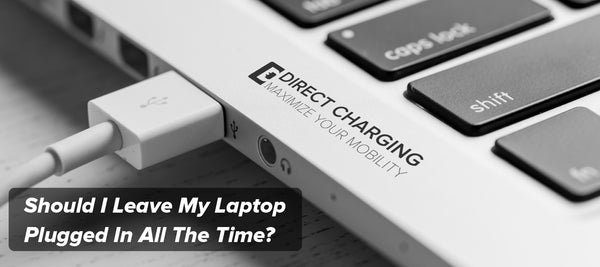
Should I Leave My Laptop Plugged In All The Time?

Should I Leave My Laptop Plugged In All The Time?
Due to our increasing dependency on our laptops, we must always be up to date when it comes to keeping them properly functioning. A particular question that often arises in any laptop-owner’s mind relates to the laptop’s battery, asking if it’s okay or not to leave the laptop constantly plugged in.
What actually goes on when you charge a laptop battery?
Let's go deeper into details and analyze what is actually happening inside a laptop battery when it is always plugged in and charging. Laptop batteries are officially called SBS (Smart Battery Systems), meaning that they come with built-in microcontrollers which manage the charging and discharging processes of the battery cells.
This means that the battery manufacturers make sure that there won't be any overcharging when the battery is always kept plugged in. Basically, the microcontroller deactivates the power lines once the battery reaches SoC (State of Charge) = 100% (Fully Charged).
What is happening next?
Once the battery reaches SoC = 100% the power is disconnected, meaning there won't be any charging current passing through. After a few days, however, the battery cells begin to naturally discharge.
In a few days, let's say from three to five, the SoC will decrease down to about 95%. At this time, the microcontroller detects this level and the charging process resumes until the battery will once again reach the “100% charged” status.
After a few days the cells will decrease in capacity again, leading to the microcontroller repeating the procedure. The behavior of a laptop battery that is always plugged-in is as follows:
- charging to 100%;
- power is disconnected by the battery electronic board;
- after some days the SoC decreases to a certain level which is different for each manufacturer;
- the charging process starts again.
The difference between a fully charged SoC (100%) and a SoC of 95% is called the hysteresis level (5%). The behavior which we presented is not very healthy for the laptop battery since the battery doesn't know the real capacity that is computed dynamically at runtime.
Keeping the battery always plugged-in for a long period could lead to the following situation: the battery reports a 3h autonomy to the Operating System but in reality it shuts down after only 30 minutes.
This is happening because the battery doesn't know its real capacity, which can only be learned after a complete discharge. The behavior involving the hysteresis level could be seen easily by testing a laptop battery with an equipment like our very own Laptop Battery Tester NLBA1 (link catre NLBA1).
The bottom line
To answer your question, it is recommended to use the battery at least a few times per month as follows: perform 1-2 full charging cycles (100% -> 0% -> 100%) in order to allow the microcontroller to learn its battery capacity.
https://www.direct-charging.com/blogs/news/how-to-repair-a-laptop-battery
https://www.direct-charging.com/blogs/news/how-to-charge-a-laptop-battery-externally-1
In Same Category
- Power banks for laptops: Easy-peasy tech for any battery. Tips and tricks for the most suitable one for you
- Charge your spare battery outside the laptop: A look on three external laptop battery chargers
- Why the health of your battery is as important as yours: The NLBA1 laptop battery analyzer
- How can you charge your laptop with a power bank?
- Laptop Battery Analyzer - the software
Related by Tags
- Power banks for laptops: Easy-peasy tech for any battery. Tips and tricks for the most suitable one for you
- Charge your spare battery outside the laptop: A look on three external laptop battery chargers
- Why the health of your battery is as important as yours: The NLBA1 laptop battery analyzer
- How can you charge your laptop with a power bank?
- Laptop Battery Analyzer - the software
- Laptop Battery Analyzer - presented by Direct Charging
- Should I Leave My Laptop Plugged In All The Time?
- How to repair a laptop battery
- Laptop battery life - How to maintain it and what to do when it’s over